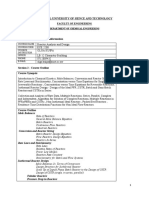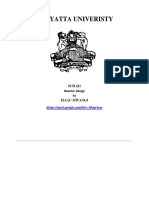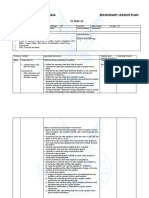3360503
3360503
Uploaded by
Pranam BhumbarCopyright:
Available Formats
3360503
3360503
Uploaded by
Pranam BhumbarOriginal Description:
Copyright
Available Formats
Share this document
Did you find this document useful?
Is this content inappropriate?
Copyright:
Available Formats
3360503
3360503
Uploaded by
Pranam BhumbarCopyright:
Available Formats
Chemical Reaction Engineering Course Code: 3360503
GUJARAT TECHNOLOGICAL UNIVERSITY, AHMEDABAD, GUJARAT
COURSE CURRICULUM
COURSE TITLE: CHEMICAL REACTION ENGINEERING
(COURSE CODE: 3360503)
Diploma Programme in which this course is offered Semester in which offered
Chemical Engineering Sixth
1. RATIONALE
Chemical reactor design uses information, knowledge, and experience from a variety of areas
like thermodynamics, chemical kinetics, fluid mechanics, heat transfer, mass transfer, and
economics. Chemical reaction engineering is the synthesis of all these factors with the aim of
properly designing a chemical reactor. The basic concepts of chemical reaction engineering
are applied to the design and operation of various commercial reactors performing non
catalytic and catalytic reactions. This course enables the diploma engineer to some extent in
accomplish the task of selecting, sizing and determining the optimal operating conditions for
the reactor.
2. COMPETENCY
The course content should be taught and curriculum should be implemented with the aim to
develop required skills in the students so that they are able to acquire following competency:
Operate and maintain various chemical reactors to produce products of desired
quality with minimum cost.
3. COURSE OUTCOMES (COs)
The theory should be taught and practical should be carried out in such a manner that students
are able to acquire required learning outcomes in cognitive, psychomotor and affective
domain to demonstrate following outcomes:
i. Explain basic concepts to distinguish chemical reactions.
ii. Calculate rate, rate constant, activation energy and order of reaction.
iii. Interpret kinetic data to find order of reactions.
iv. Operate different reactors efficiently using basic knowledge about their functioning
v. Calculate volume, space time and space velocity for Ideal reactors.
4. TEACHING AND EXAMINATION SCHEME
Teaching Scheme Total Credits Examination Scheme
(In Hours) (L+T+P) Theory Marks Practical Marks Total
Marks
L T P C ESE PA ESE PA
100
3 2 0 5 70 30 00 00
Legends: L - Lecture; T - Tutorial/Teacher Guided Student Activity; P - Practical; C-
Credit; ESE - End Semester Examination; PA - Progressive Assessment
GTU/NITTTR/Bhopal/14 Gujarat State
1
Chemical Reaction Engineering Course Code: 3360503
5. COURSE CONTENT DETAILS
Unit Major Learning Outcomes Topics and Sub-topics
(In Cognitive Domain)
Unit – I 1a. Differentiate between 1.1 Scope and importance of chemical
Basics various types of reactions such reaction engineering
of as chemical reactions Catalytic 1.2 Classification of chemical reactions,
Chemical vs. Non-catalytic and the like a. Homogeneous vs. Heterogeneous,
Reactions 1b. Describe the factors b. Catalytic vs. Non-catalytic
affecting rate of reaction c. Reversible vs. Irreversible
d. By Molecularity
e. Exothermic vs. Endothermic
f. By order of reaction
1.3 Reaction rate on various basis and
variables affecting the rate of
reaction.
Unit – II 2a. Derive the rate law 2.1 Rate equation/ Rate law
Kinetics 2b. Calculate rate constant 2.2 Concentration dependent term of
of 2c. Estimate Molecularity and rate
Homogeneous order of reaction Equation, Rate constant, Elementary
Reactions and non-elementary reactions
2.3 Molecularity and order of reaction
2d. Explain temperature 2.4 Temperature dependent term of rate
dependency Equation, Temperature dependency
from Arrhenius law from Arrhenius law
2e. Describe the significance 2.5 Activation energy
of activation energy
2f. Calculate activation energy
Unit – III 3a. Describe the methods for 3.1 Methods for analysis of kinetic data
Interpretation analysis of kinetic data Differential vs. Integral method
of 3b. Explain the relationships Half life method
batch reactor for constant volume batch 3.2 Relationship for constant volume
data reaction system batch reaction system
3.3 Total pressure of the system and the
partial pressure of reacting material
Concentration and Conversion
3c. Derive integrated rate 3.4 Integrated rate equation for different
equations order of irreversible reactions: Uni-
molecular first order, Bi-molecular,
Second order, Tri-molecular third
order, nth order, Zero order
Unit – IV 4a. Describe an ideal reactors 4.1 Features of ideal reactors
Ideal 4b. Describe the construction, 4.2 Different types of reactors: Batch
reactors benefits, limitations and reactor, Semi batch reactor, Flow
applications of different types reactors, MFR/CSTR, PFR
of reactors such as batch (Tubular), Fixed bed reactors,
reactors and others. Fluidised bed reactors
GTU/NITTTR/Bhopal/14 Gujarat State
2
Chemical Reaction Engineering Course Code: 3360503
Unit Major Learning Outcomes Topics and Sub-topics
(In Cognitive Domain)
4c. Describe the construction, 4.3 Multi phase reactors: G-L-S reactor,
benefits, limitations and Slurry reactor, Bubble column
applications of different types reactor, Spray reactor, Trickle bed
of multiphase reactors such as reactor
slurry reactor and others
Unit – V 5a. Explain the performance 5.1 Performance equation of : Single
Design equation of different types of Ideal reactor for Single reaction
of reactors such as Ideal batch Constant density system, Ideal batch
single reactor and others reactor, Steady state mixed flow
Ideal reactor reactor, Steady state plug flow
reactor
5b. Explain space time and 5.2 Flow reactors: Space time, Space
space velocity velocity, Holding time Vs. Space
5c. Differentiate holding time time
and Space time
5d. Calculate time/volume of
reactor.
6. SUGGESTED SPECIFICATION TABLE WITH HOURS and MARKS (Theory)
Unit Unit Title Teaching Distribution of Theory Marks
Hours R U A Total
Level Level Level Marks
I Basics of Chemical 6 3 4 3 10
Reactions
II Kinetics of Homogeneous 8 4 6 4 14
reactions
III Interpretation of batch 8 4 6 4 14
reactor data
IV Ideal reactors 10 6 6 4 16
V Design of single Ideal 10 4 5 7 16
rector
Total 42 21 27 22 70
Legends: R = Remember, U = Understand, A= Apply and above Level (Bloom’s revised
taxonomy)
Note: This specification table shall be treated as a general guideline for students and teachers.
The actual distribution of marks in the question paper may vary slightly from above table.
7. SUGGESTED TUTORIALS
In tutorials numerical or conceptual problems may be given to individual or group of students.
Students should be first allowed to struggle on their own to find the solution, and should try
their creativity. However, faculty should remain around the students and help them if they are
not able to proceed.
It is better if real life problems are case studies are given where different groups of students
may come with different solutions, which can be discussed in a larger group of student to
GTU/NITTTR/Bhopal/14 Gujarat State
3
Chemical Reaction Engineering Course Code: 3360503
generate more discussions. Following is the suggestive list of exercises; concerned faculty may
change/add exercises to this list.
S. Unit Tutorial Exercises Approx.
No. No. Hours
Required
1 I Classify chemical reactions and express rate on various basis 2
2 I Solve the given problems based on rate equation 2
3 II Solve given problems based on molecularity and order of reaction 2
4 II Discuss temperature dependency of rate from Arrhenius' Law and 4
solve given problems based on Arrhenius law
5 III Explain various methods of kinetic data analysis 2
6 III Derive integrated rate equation for different order of reaction 4
7 IV Explain different Ideal reactors with sketch 2
8 IV Explain different multiphase reactors with sketch 2
9 V Derive performance equation of Ideal batch, mixed flow and plug 2
flow reactor
10 V Solve given problems based on performance equation of Ideal batch 2
reactor
11 V Solve given problems based on performance equation of Ideal 2
mixed flow reactor
12 V Solve given problems based on performance equation of Ideal Plug 2
flow reactor
Total 28
8. SUGGESTED STUDENT ACTIVITIES
Following is the list of proposed student activities. These could be individual and group
based.
i. Explore internet, visit websites of reputed chemical production companies and prepare
ppt presentations on different topics (in group of four-five) and present in class
ii. Refer books by different authors and solve as many numerical problems (related to
above content) as possible. This will improve your understanding of effect of
different parameters on functioning of reactors.
9. SPECIAL INSTRUCTIONAL STRATEGY (If Any)
i. Use online course material from reputed universities
ii. Arrange expert lectures
iii. Give as many types of numerical problems to students as many possible and explain
one example of each type of problem in detail.
10 SUGGESTED LEARNING RESOURCES
A) Books
S. Title of Books Author Publication
No.
Third Edition,
1 Chemical Reaction Engineering Octave Levenspiel
John Wiley and Sons
Essentials of Chemical Reaction Fourth Edition,
2 H. Scott Fogler
Engineering Prentice Hall International
The Engineering of Chemical Second Edition,
3 Lanny D. Schmidt
Reactions Oxford University Press
GTU/NITTTR/Bhopal/14 Gujarat State
4
Chemical Reaction Engineering Course Code: 3360503
B) Major Equipment/Materials with Broad Specifications
--Nil--
C) Software/Learning Websites
i. http://nptel.ac.in/courses/103108097/
ii. http://www.umich.edu/~elements/toc/frames.htm
iii. http://ocw.mit.edu/courses/chemical-engineering/10-37-chemical-and-biological-
reaction-engineering-spring-2007/lecture-notes/
11. COURSE CURRICULUM DEVELOPMENT COMMITTEE
Faculty Members from Polytechnics
Prof. Kartik R. Desai, Head, Chemical Engg. Dept., N. G. Patel Polytechnic, Isroli-
Afwa
Prof. Mukesh B. Dhangar, Lecturer, Chemical Engg. Dept., N. G. Patel Polytechnic,
Isroli-Afwa
Prof. Shilpaben Patel, Lecturer, Chemical Engg. Dept., Govt. Polytechnic,
Gandhinagar
Coordinators andFaculty Members from NITTTR Bhopal
Dr. Bashirulla Shaik, Assistant Professor, Department of Applied Sciences
Dr. Joshua Earnest, Professor of Electrical & Electronics Engineering.
GTU/NITTTR/Bhopal/14 Gujarat State
5
You might also like
- Kinetic Reactor Design Lecture Note 1-1Document31 pagesKinetic Reactor Design Lecture Note 1-1Khairul Imran Azman100% (1)
- Iso 2867-1994Document16 pagesIso 2867-1994activedeen100% (1)
- Installation and Use GuideDocument17 pagesInstallation and Use GuideNc NikNo ratings yet
- Project 2 Planning Document - Egr 100Document7 pagesProject 2 Planning Document - Egr 100api-542535294No ratings yet
- Rotations of ShapesDocument4 pagesRotations of ShapesThanusha DhanarajNo ratings yet
- Che F311 Kinetics Reactor Design - HandoutDocument2 pagesChe F311 Kinetics Reactor Design - HandoutAzureNo ratings yet
- Chemical Reaction Engineering 1-3160506Document4 pagesChemical Reaction Engineering 1-3160506darshanve1722No ratings yet
- Gujarat Technological University: W.E.F. AY 2018-19Document4 pagesGujarat Technological University: W.E.F. AY 2018-19MohitSathwara 2609No ratings yet
- Instruction Division FIRST SEMESTER 2018-2019: Course No. Course Title Instructor-in-ChargeDocument2 pagesInstruction Division FIRST SEMESTER 2018-2019: Course No. Course Title Instructor-in-ChargeAyush PorwalNo ratings yet
- National University of Sience and TechnologyDocument3 pagesNational University of Sience and TechnologypalesaNo ratings yet
- Che346 Course CompactDocument5 pagesChe346 Course Compactpeter-albert.danielNo ratings yet
- Lesson Plan Reaction Engineering 1Document4 pagesLesson Plan Reaction Engineering 1EreenNo ratings yet
- ACF DesignDocument5 pagesACF DesignRonald ManyamaNo ratings yet
- CHE_F311_1184_20240811193814Document5 pagesCHE_F311_1184_20240811193814f20221598No ratings yet
- FIRST NOTES January 2021Document37 pagesFIRST NOTES January 2021vivaline AchiengNo ratings yet
- AUGS/ AGSR Division: Birla Institute of Technology and Science, Pilani Pilani CampusDocument6 pagesAUGS/ AGSR Division: Birla Institute of Technology and Science, Pilani Pilani CampusHIMANSHU SHARMANo ratings yet
- National University of EngineeringDocument2 pagesNational University of EngineeringMarco A. Castillo LudeñaNo ratings yet
- Lesson Plan Year 11 Chemical KineticsDocument4 pagesLesson Plan Year 11 Chemical KineticsJoko SusiloNo ratings yet
- Lesson Plan CHE505 Reaction Engineering II OCT2024-FEB2025.docx_signDocument10 pagesLesson Plan CHE505 Reaction Engineering II OCT2024-FEB2025.docx_sign2021603868No ratings yet
- 477306S Article1 Extra PDFDocument36 pages477306S Article1 Extra PDFCharlieWallNo ratings yet
- Assignment 1 Effective TeachingDocument3 pagesAssignment 1 Effective TeachingNishant KhandelwalNo ratings yet
- 21CH54-CRE SchemeDocument2 pages21CH54-CRE Schemehemanthkumar7834No ratings yet
- CHE F311 Kinetics and Reactor DesignDocument2 pagesCHE F311 Kinetics and Reactor DesignshreyNo ratings yet
- Chemical Engineering Thermodynamics Course Code: 3350505Document5 pagesChemical Engineering Thermodynamics Course Code: 3350505Arpit vaishnavNo ratings yet
- Reactor Design (I) : Chemical IdentityDocument5 pagesReactor Design (I) : Chemical Identityنزار الدهاميNo ratings yet
- Ch-254 Chemical Reaction Engineering - I L-T-P (3-1-0) 4 Credits Teaching Plan Lecture ScheduleDocument2 pagesCh-254 Chemical Reaction Engineering - I L-T-P (3-1-0) 4 Credits Teaching Plan Lecture SchedulezxcvbnmNo ratings yet
- Cheng 323 Chap 4 Sem II 2012-13Document96 pagesCheng 323 Chap 4 Sem II 2012-13Faisal MumtazNo ratings yet
- Nptel: Chemical Reaction Engineering II - Web CourseDocument2 pagesNptel: Chemical Reaction Engineering II - Web CourseBuxNo ratings yet
- Kinetics and Reactor Design: INSTRUCTOR: Dr. Nabeel Salim Abo-GhanderDocument19 pagesKinetics and Reactor Design: INSTRUCTOR: Dr. Nabeel Salim Abo-GhanderNelson HNo ratings yet
- University of Engineering and Technology Lahore: Department: Chemical Engineering Section Course Outline ReportDocument2 pagesUniversity of Engineering and Technology Lahore: Department: Chemical Engineering Section Course Outline ReportMuhammad AliNo ratings yet
- Cre SyllabusDocument2 pagesCre SyllabusRuhee ShaikNo ratings yet
- U3 Kinetics Anchor GuideDocument19 pagesU3 Kinetics Anchor GuiderorrewingNo ratings yet
- Chemical Reaction Engineering: RD THDocument2 pagesChemical Reaction Engineering: RD THAmol RastogiNo ratings yet
- Cheng 323 Chap 4Document82 pagesCheng 323 Chap 4Faisal Mumtaz100% (2)
- CRE Notes AMUDocument136 pagesCRE Notes AMUsatya.usct.900450No ratings yet
- Preview-9781351419666 A37407735Document46 pagesPreview-9781351419666 A37407735sinakiani71No ratings yet
- Kinetics and Reactor Design: INSTRUCTOR: Dr. Nabeel Salim Abo-GhanderDocument19 pagesKinetics and Reactor Design: INSTRUCTOR: Dr. Nabeel Salim Abo-GhanderJesslyn Alejandra Collantes OrbeaNo ratings yet
- CREII-Module-I - Lecture 1Document38 pagesCREII-Module-I - Lecture 1Aditya parasNo ratings yet
- V Sem - Syllabus200824024819Document16 pagesV Sem - Syllabus200824024819mishramanas0707No ratings yet
- 3360901Document7 pages3360901vims1248993No ratings yet
- 1974Document20 pages1974Deneme YanılmaNo ratings yet
- Isha Mukherjee - Chemistry PaperDocument19 pagesIsha Mukherjee - Chemistry Paperishamukherjee2024No ratings yet
- CHT204Document1 pageCHT204Manoj MorwalNo ratings yet
- CET II (3140507) Study MaterialDocument37 pagesCET II (3140507) Study MaterialAkasH BinDNo ratings yet
- CH CRE Sample Career Avenues PDFDocument13 pagesCH CRE Sample Career Avenues PDFPravin AgalaveNo ratings yet
- Instant ebooks textbook Essentials of Chemical Reaction Engineering 2nd 2nd Edition H. Scott Fogler download all chaptersDocument39 pagesInstant ebooks textbook Essentials of Chemical Reaction Engineering 2nd 2nd Edition H. Scott Fogler download all chaptersnauglehejman100% (2)
- Gujarat Technological University: W.E.F. AY 2018-19Document4 pagesGujarat Technological University: W.E.F. AY 2018-19HirenNo ratings yet
- FALLSEM2023-24 BCHE303L TH VL2023240100107 2023-04-29 Reference-Material-IDocument29 pagesFALLSEM2023-24 BCHE303L TH VL2023240100107 2023-04-29 Reference-Material-Isaswata299No ratings yet
- Lecture 1 Che KineticsDocument24 pagesLecture 1 Che KineticsnoelNo ratings yet
- Dec 4,5,6, 2019 DLPDocument2 pagesDec 4,5,6, 2019 DLPJedidiah Jara Quidet100% (1)
- Chemical Reaction Engineering-IIDocument3 pagesChemical Reaction Engineering-II2020001873.gcetNo ratings yet
- SyllabusDocument22 pagesSyllabusSohael AftabNo ratings yet
- Reactor Types and Their Industrial ApplicationsDocument33 pagesReactor Types and Their Industrial Applicationstacos1705100% (6)
- Lesson Plan - KMJ32003 - Sem 1 - 2425Document5 pagesLesson Plan - KMJ32003 - Sem 1 - 2425s221141757No ratings yet
- University of Petroleum & Energy Studies College of Engineering Studies Dehradun Course PlanDocument7 pagesUniversity of Petroleum & Energy Studies College of Engineering Studies Dehradun Course PlanSwapnil TripathiNo ratings yet
- Chemical Sem7Document19 pagesChemical Sem7190110105035No ratings yet
- Chemistry - SS2 - Scheme (1) First and Second TermDocument12 pagesChemistry - SS2 - Scheme (1) First and Second TermDenzel MusaNo ratings yet
- Industrial Transducers Course Code: 3321701Document6 pagesIndustrial Transducers Course Code: 3321701Rohan MathurNo ratings yet
- Teaching Schedule Chem-609 TheoryDocument6 pagesTeaching Schedule Chem-609 TheoryDr-SabaJamilNo ratings yet
- Ucsi University B.Eng (Hons) in Chemical Engineering Course OutlineDocument2 pagesUcsi University B.Eng (Hons) in Chemical Engineering Course OutlinetkjingNo ratings yet
- Competency: Mass Transfer-I Course Code: 3340502Document7 pagesCompetency: Mass Transfer-I Course Code: 3340502Dope WorldNo ratings yet
- Membrane Reactor Engineering: Applications for a Greener Process IndustryFrom EverandMembrane Reactor Engineering: Applications for a Greener Process IndustryNo ratings yet
- Combinatorial Geometry Handout - Phoenixfire-23-40Document18 pagesCombinatorial Geometry Handout - Phoenixfire-23-40Yash VardhanNo ratings yet
- Fluid Statistics and Dynamic Study Materials PDFDocument11 pagesFluid Statistics and Dynamic Study Materials PDFMurugeswariNo ratings yet
- Compact Micro Strip Patch Antenna For Wlan Application: A Project ReportDocument67 pagesCompact Micro Strip Patch Antenna For Wlan Application: A Project ReportBavithraNo ratings yet
- Introduction To UT Flaw DetectorDocument26 pagesIntroduction To UT Flaw DetectorNail Widya Satya100% (2)
- Finding The Inverse Reflection Using Transformation Table of ValuesDocument3 pagesFinding The Inverse Reflection Using Transformation Table of ValuesPuneet SehgalNo ratings yet
- SAPCVDocument8 pagesSAPCVsanthaNo ratings yet
- Mousa The Soil Ionization GradientDocument9 pagesMousa The Soil Ionization GradientAjay JayabalanNo ratings yet
- List of PhysicistsDocument141 pagesList of PhysicistsvideoeditinggalaxyNo ratings yet
- Type SDFC Sizes 290 To 1040 - EngDocument2 pagesType SDFC Sizes 290 To 1040 - EngKUNALJAY100% (3)
- Good Conductors of Heat and Electricity: Grade 5 Quarter 3 Week 2Document25 pagesGood Conductors of Heat and Electricity: Grade 5 Quarter 3 Week 2ROSE ANN MANLULUNo ratings yet
- Assignment 7: Thermodynamic Property Relations: ME523 Advanced ThermodynamicsDocument1 pageAssignment 7: Thermodynamic Property Relations: ME523 Advanced ThermodynamicsAryanSharmaNo ratings yet
- Midterm Exam: MET246E Materials PhysicsDocument6 pagesMidterm Exam: MET246E Materials PhysicsbazingaNo ratings yet
- 1d Collisions Lab ReportDocument8 pages1d Collisions Lab ReportSimon WairimuNo ratings yet
- ECG MatlabDocument4 pagesECG MatlabPavan PakkiNo ratings yet
- Storage Tank Cooling SprinklersDocument3 pagesStorage Tank Cooling Sprinklershappale2002No ratings yet
- Static and Dynamic Behavior of Extradosed Bridges - KoffiDocument98 pagesStatic and Dynamic Behavior of Extradosed Bridges - Koffikfdani100% (1)
- Bahcesehir Calculus Sinav OrnegiDocument6 pagesBahcesehir Calculus Sinav OrnegiArzu KerimNo ratings yet
- Telemecanique Sensors - Reliability Data For PL Calculation - MTTFD - B10D - April 21,2021 - 10th Release - SistemaV2Document24 pagesTelemecanique Sensors - Reliability Data For PL Calculation - MTTFD - B10D - April 21,2021 - 10th Release - SistemaV2jucivanio10No ratings yet
- Wheatstone BridgeDocument18 pagesWheatstone Bridgethiagarajan sNo ratings yet
- Tarea No 7 ExergiaDocument3 pagesTarea No 7 ExergiaAndres RomeroNo ratings yet
- General How To Approach Olympiad ProblemsDocument6 pagesGeneral How To Approach Olympiad ProblemsaniketNo ratings yet
- 7.0 Punching Check: 7.1 Punching of Column in Column CapitalDocument6 pages7.0 Punching Check: 7.1 Punching of Column in Column CapitalVikasNo ratings yet
- 7th Grade Unit 1 Scale Drawings: Start: End: PurposeDocument17 pages7th Grade Unit 1 Scale Drawings: Start: End: PurposeWendy TiedtNo ratings yet
- Matlab: The Language of Technical ComputingDocument27 pagesMatlab: The Language of Technical Computingrauk83No ratings yet
- Lab Report No: 06 Title:: Figure Parallel Forces ApparatusDocument6 pagesLab Report No: 06 Title:: Figure Parallel Forces ApparatusSajid KhanNo ratings yet
- Beyond Pluto, Exploring The Outer Limits of Solar SystemDocument247 pagesBeyond Pluto, Exploring The Outer Limits of Solar SystemGihan Shanaka100% (3)

























































































